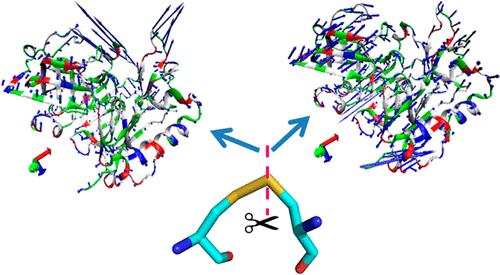当前位置:
X-MOL 学术
›
ACS Chem. Neurosci.
›
论文详情
Our official English website, www.x-mol.net, welcomes your
feedback! (Note: you will need to create a separate account there.)
Effects of Disulfide Bonds on Binding of Inhibitors to β-Amyloid Cleaving Enzyme 1 Decoded by Multiple Replica Accelerated Molecular Dynamics Simulations.
ACS Chemical Neuroscience ( IF 4.1 ) Pub Date : 2020-05-27 , DOI: 10.1021/acschemneuro.0c00234 Jianzhong Chen 1 , Baohua Yin 2 , Wei Wang 1 , Haibo Sun 1
ACS Chemical Neuroscience ( IF 4.1 ) Pub Date : 2020-05-27 , DOI: 10.1021/acschemneuro.0c00234 Jianzhong Chen 1 , Baohua Yin 2 , Wei Wang 1 , Haibo Sun 1
Affiliation

|
The β-amyloid cleaving enzyme 1 (BACE1) has been thought to be an efficient target for treatment of Alzheimer’s disease (AD). Deep insight into inhibitor–BACE1 binding mechanism is of significance for design of potent drugs toward BACE1. In this work, multiple replica accelerated molecular dynamics (MR-aMD) simulations, principal component (PC) analysis, and free energy landscapes were integrated to decode the effect of disulfide bonds (SSBs) in BACE1 on bindings of three inhibitors 3KO, 3KT, and 779 to BACE1. The results from cross-correlation analysis suggest that the breaking of SSBs exerts significant influence on structural flexibility and internal dynamics of inhibitor-bound BACE1. PC analysis and free energy landscapes reveal that the breaking of SSBs not only evidently induces the conformational rearrangement of BACE1 but also highly changes binding poses of three inhibitors in BACE1 and leads to more disordered binding of three inhibitors to BACE1, which is further supported by the increase in binding entropy of inhibitors to BACE1 due to the breaking of SSBs. Residue-based free energy decomposition method was utilized to evaluate contributions of separate residues to inhibitor–BACE1 binding. The results suggest that although the breaking of SSBs in BACE1 does not destroy the interaction network of inhibitors with BACE1 it changes interaction strength of some residues with inhibitors. Meanwhile, the information from residue-based free energy decomposition indicates that residues L91, S96, V130, Y132, Q134, W137, F169, I171, and I179 can be used as efficient targets of drug design toward BACE1.
中文翻译:

二硫键对抑制剂与 β-淀粉样蛋白裂解酶 1 结合的影响,通过多重复制加速分子动力学模拟解码。
β-淀粉样蛋白裂解酶 1 (BACE1) 被认为是治疗阿尔茨海默病 (AD) 的有效靶标。深入了解抑制剂-BACE1 结合机制对于设计针对 BACE1 的强效药物具有重要意义。在这项工作中,将多个复制加速分子动力学 (MR-aMD) 模拟、主成分 (PC) 分析和自由能图相结合,以解码 BACE1 中二硫键 (SSB) 对三种抑制剂 3KO、3KT、和 779 到 BACE1。互相关分析的结果表明,SSBs 的断裂对抑制剂结合的 BACE1 的结构灵活性和内部动力学产生了显着影响。PC 分析和自由能图表明,SSBs 的破坏不仅明显诱导 BACE1 的构象重排,而且高度改变了 BACE1 中三种抑制剂的结合位姿,导致三种抑制剂与 BACE1 的结合更加无序,这进一步得到了 BACE1 的支持。由于 SSB 的破坏,抑制剂与 BACE1 的结合熵增加。基于残基的自由能分解方法用于评估单独残基对抑制剂-BACE1结合的贡献。结果表明,尽管 BACE1 中 SSB 的破坏不会破坏抑制剂与 BACE1 的相互作用网络,但它会改变一些残基与抑制剂的相互作用强度。同时,基于残基的自由能分解信息表明残基 L91、S96、V130、Y132、Q134、W137、F169、
更新日期:2020-05-27
中文翻译:

二硫键对抑制剂与 β-淀粉样蛋白裂解酶 1 结合的影响,通过多重复制加速分子动力学模拟解码。
β-淀粉样蛋白裂解酶 1 (BACE1) 被认为是治疗阿尔茨海默病 (AD) 的有效靶标。深入了解抑制剂-BACE1 结合机制对于设计针对 BACE1 的强效药物具有重要意义。在这项工作中,将多个复制加速分子动力学 (MR-aMD) 模拟、主成分 (PC) 分析和自由能图相结合,以解码 BACE1 中二硫键 (SSB) 对三种抑制剂 3KO、3KT、和 779 到 BACE1。互相关分析的结果表明,SSBs 的断裂对抑制剂结合的 BACE1 的结构灵活性和内部动力学产生了显着影响。PC 分析和自由能图表明,SSBs 的破坏不仅明显诱导 BACE1 的构象重排,而且高度改变了 BACE1 中三种抑制剂的结合位姿,导致三种抑制剂与 BACE1 的结合更加无序,这进一步得到了 BACE1 的支持。由于 SSB 的破坏,抑制剂与 BACE1 的结合熵增加。基于残基的自由能分解方法用于评估单独残基对抑制剂-BACE1结合的贡献。结果表明,尽管 BACE1 中 SSB 的破坏不会破坏抑制剂与 BACE1 的相互作用网络,但它会改变一些残基与抑制剂的相互作用强度。同时,基于残基的自由能分解信息表明残基 L91、S96、V130、Y132、Q134、W137、F169、









































 京公网安备 11010802027423号
京公网安备 11010802027423号